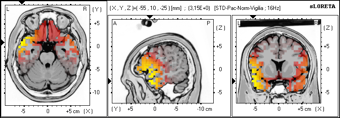Is it possible a recovery from tinnitus pathology?
Tinnitology i.e., the science in charge of diagnosis and treatment of tinnitus has achieved a very important development in the last two years.
It is very common receiving patients who having previously consulted on this pathology to numerous doctors have received the following answer:
“there is no cure for tinnitus, get used to live with it”.
Same as in dizziness treatment, tinnitus pharmacological treatment is our choice.
Planning a rational therapy in line with tinnitus topodiagnosis considering the different tests of neurootological research:
- Typified Anamnesis
- Tonal, Verbal Audiometry and Supraliminal Tests
- Impedanciometry
- Otoaccoustic Issue
- Fast Evoked Potentials of Brain Stem - BSER
- Slow Auditory Evoked Potentials of Brain Cortex - ALEP
- Cognitive Potentials - P300
- Computing Brain Mapping and Potential Mapping - BEAM
- Brain Electric Tomography - LORETA
allow the use of medicines or a combination of them capable of acting on a particular neurotransmitter in their different presentations.
In tinnitus therapeutic pattern developed by us Bergmann-Bertora (2008), we based on the auditory via chart and on the cortical-thalamus-striated-cortico control system.
The Brain Electric Tomography is the most accurate study to locate dysfunctions of the cortical-thalamus-striated-cortico system.
Cortical Brain Areas (BA) and brain rhythm variations in tinnitus patients.

Ritmo ßeta 1 – 12,5 – 16 hz
BA 21 - Middle temporal Gyrus – Temporal Lobe

Ritmo ßeta 2 – 18,5 – 21 hz
BA 22 – Superior temporal Gyrus – Temporal Lobe

Ritmo ßeta 3 - 21,5 – 30 hz -
BA 47 - Inferior frontal Gyrus- Frontal Lobe
The chosen medicine or neurotransmitter will be directed towards regulation of neuronal hyperactivity or hypoactivity situations, according to tinnitus topographical location, being this diagnosis habitual for us in our daily work by means of the different tests used in establishing a diagnosis in modern tinnitology.
In view of the above said, it is very easy to understand that it is impossible to treat tinnitus by a monodrug, but it is necessary to use a combination of numerous neurotransmitters capable of regulating the hyper / hypofunction phenomena in line with the different topographical locations.
The different test methods used by us make an excellent method for basing on and managing a therapy, also capable of checking results of it while time passed.
An statistical evaluation of 1480 patients under study, (Bergmann-Bertora) quantitatively before and after treatment allows us to state that:
- 61% showed a complete restitution of tinnitus
- 30% an important decrease of the symptom which allows people to follow a normal lifestyle.
- 9% of cases do not show any improvement in symptoms or reasons on which consultation was originated.
Tinnitus and dizzines represent those diseases which are of a chronic type in a very high percentage, as it is the case of presbyataxia and presbytinnitus. Therefore, as it is the case of other pathologies - diabetes, hypertension and hyperthyroidism - the treatment should be supporting and permanent.
Our research and publications
- Archivos de Sensología y Neurootología en Ciencia y Práctica Médica. ASN – Archives for Sensology and Neurootology in Science and Practice. ASN
XXXIX Congress of the NES – Bad Kissingen – Germany – April 2012
Obsessive-Compulsive Disorder and Tinnitus: The ethiopatogenic mechanism , studied with Brain Electric Tomography (LORETA)
Dr.med. Julia M. Bergmann, Dr.med. Guillermo O. Bertora (Buenos Aires - Argentina) - Archivos de Sensología y Neurootología en Ciencia y Práctica Médica. ASN – Archives for Sensology and Neurootology in Science and Practice. ASN
XXXVII Congress of the NES – Bad Kissingen – Germany – 2010
Tinnitus: A New Model of Pharmacological Therapy
Dr.med. Julia M. Bergmann, Dr.med. Guillermo O. Bertora (Buenos Aires - Argentina)